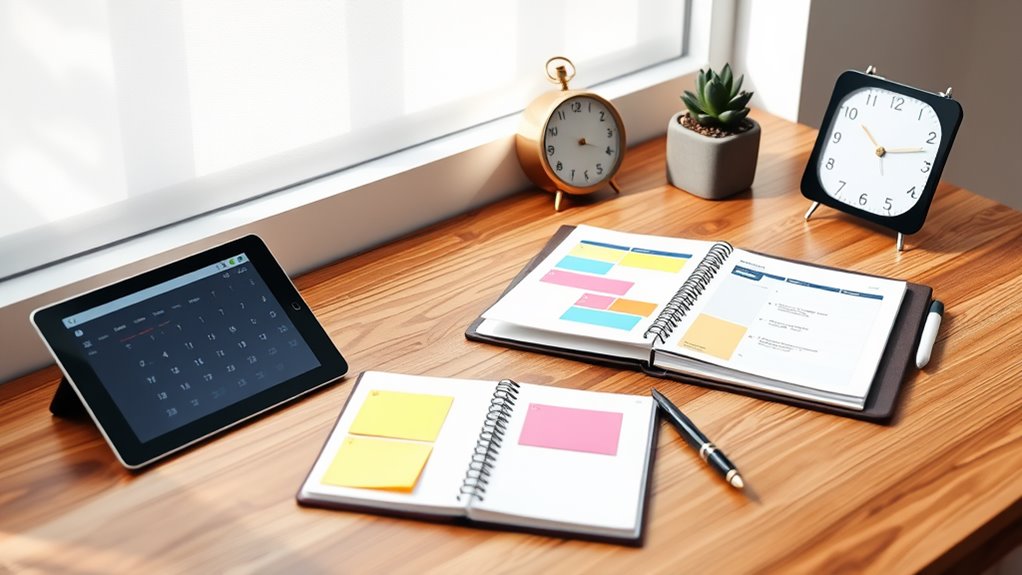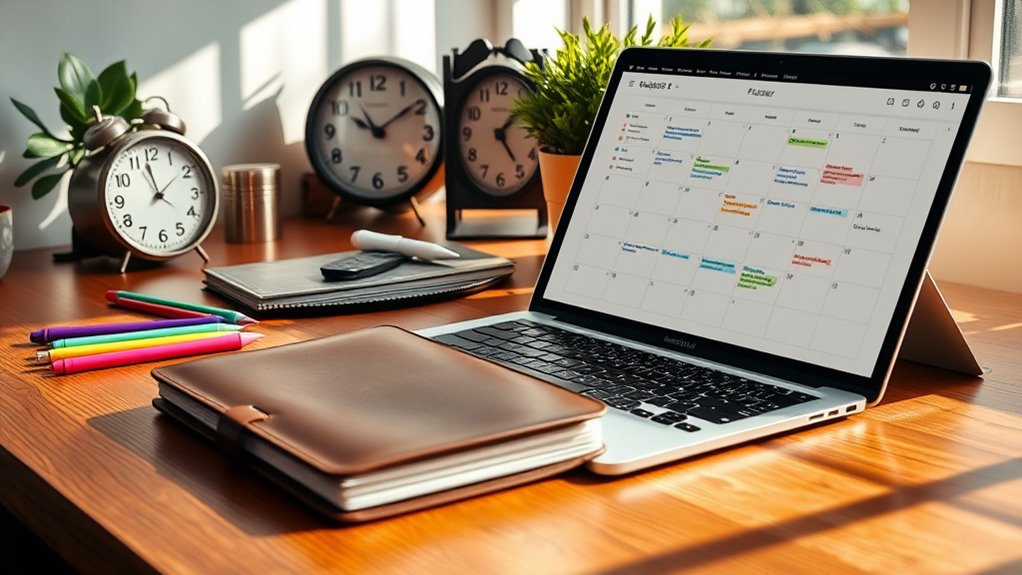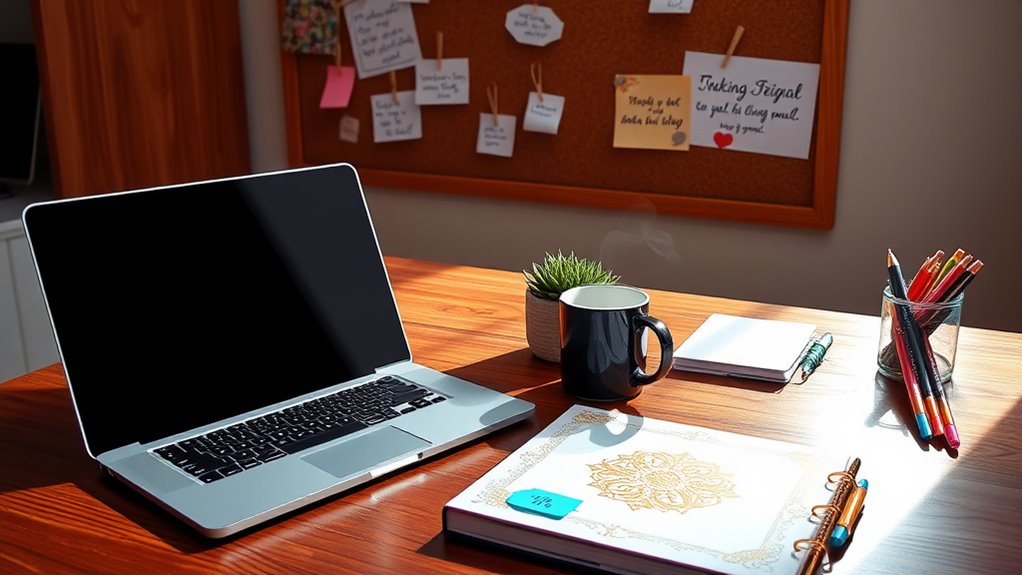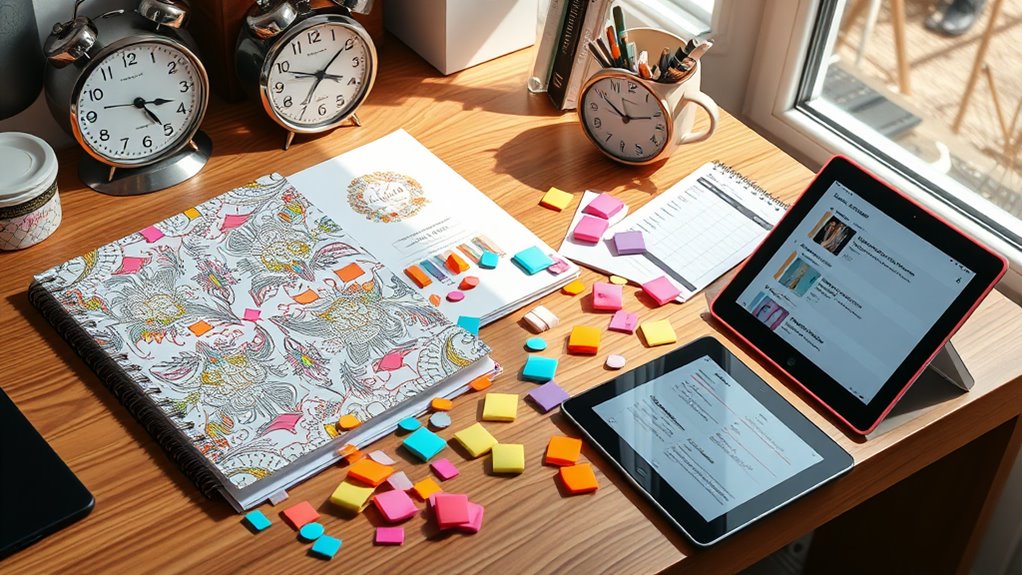The Best Planning Tools You Need in Your Life Right Now
You need effective planning tools to streamline your life and hit your goals. Digital planning apps like Todoist and Trello keep you organized and let you sync tasks across devices. If you prefer a break from screens, analog planners offer a hands-on way to reflect and stay intentional. Time management tools, such as Google Calendar and Pomodoro timers, help you allocate your day efficiently. Don’t forget goal-setting frameworks, like SMART and OKRs, to clarify your objectives. With so many options available, it’s easy to find a fit for your lifestyle. There’s even more to explore that can boost your planning game!
Key Takeaways
- Digital Planning Apps like Todoist and Trello provide versatile schedule management and collaboration features across devices for seamless organization.
- Analog Planners and Journals offer a distraction-free space for reflection, creativity, and enhanced memory through the act of writing.
- Time Management Tools such as Google Calendar and Pomodoro timers help organize tasks visually and encourage focused work sessions.
- Goal Setting Frameworks like SMART and OKRs ensure your goals are clear, measurable, and aligned with your desired outcomes.
- Collaborative Planning Solutions promote teamwork and enhance project management with real-time communication, document sharing, and customizable templates.
Digital Planning Apps
How can you stay organized in today’s fast-paced world? Digital planning apps are your best friends. They offer convenience and versatility, allowing you to manage your schedule from anywhere.
Instead of juggling paper notes, you can quickly add tasks, set reminders, and prioritize your day. Apps like Todoist or Trello enable you to create to-do lists that you can easily share with others, making collaboration a breeze.
Plus, many apps sync across devices, so you’ll always have access to your plans. You can customize notifications to stay on track and avoid missing important deadlines.
Embracing these tools not only simplifies your life but also helps you focus on what truly matters, ensuring you’re always ahead in your busy routine.
Analog Planners and Journals
Many people find that using analog planners and journals offers a revitalizing break from digital distractions. When you put pen to paper, you engage your mind in a unique way, enhancing memory and creativity. You can jot down your thoughts, set goals, and track your progress without the constant ping of notifications.
Choosing an analog planner allows you to customize your layout, making it a personal reflection of your style. You can doodle, sketch, or use colorful markers to make planning enjoyable.
Journals can act as a safe space for reflection and gratitude, helping you process daily experiences. Embracing this tactile approach can lead to greater focus and intentionality in your life, making you feel more grounded and in control.
Time Management Tools
Although distractions are everywhere, effective time management tools can help you regain control of your schedule.
Start by using digital calendars like Google Calendar or Outlook to organize your appointments and deadlines visually. These tools send reminders, so you won’t miss important events.
Next, consider time-blocking apps like Clockify or Toggl to allocate specific periods for tasks, helping you focus on one thing at a time.
You might also try the Pomodoro Technique with timers like Focus Booster, breaking work into manageable chunks with short breaks in between.
Finally, daily to-do list apps such as Todoist can keep you organized and accountable.
Goal Setting Frameworks
Once you’ve mastered time management tools, it’s time to focus on goal setting frameworks that can guide your efforts.
Using a framework like SMART (Specific, Measurable, Achievable, Relevant, Time-bound) helps you create clear and actionable goals. This method guarantees you know exactly what you’re aiming for and can track your progress effectively.
Another great option is OKRs (Objectives and Key Results), which allows you to align your goals with measurable outcomes, keeping you accountable and motivated.
You might also consider the WOOP method (Wish, Outcome, Obstacle, Plan) to anticipate challenges and develop strategies to overcome them.
Collaborative Planning Solutions
As you immerse yourself in collaborative planning solutions, you’ll discover that these tools can greatly enhance teamwork and streamline project management.
Whether you’re working with remote teams or in-person groups, these solutions foster real-time communication and idea sharing. You can easily collaborate on project timelines, assign tasks, and update progress, ensuring everyone’s on the same page.
With features like document sharing and integrated chat, you won’t miss vital updates or discussions.
Plus, many platforms offer customizable templates tailored to your specific needs, making it easier to adapt to various projects.
By using collaborative planning tools, you’ll not only improve efficiency but also create a more inclusive environment where every team member feels valued and heard.
Embrace these solutions, and watch your projects thrive!
Task Management Software
When you’re juggling multiple projects and deadlines, effective task management software can be a game changer. It helps you stay organized, prioritize tasks, and track your progress.
With the right tools, you can avoid feeling overwhelmed and guarantee nothing falls through the cracks. Here are some features to look for:
- User-friendly interface for easy navigation
- Task prioritization to focus on what matters
- Collaboration tools for team communication
- Progress tracking to monitor deadlines
- Integration with other apps for seamless workflow
Budgeting and Financial Tools
Effective budgeting and financial tools can make a significant difference in managing your projects and expenses. You need tools that help you track income, expenses, and savings.
Apps like Mint and YNAB (You Need A Budget) allow you to create budgets tailored to your lifestyle, giving you insights into your spending habits.
Using spreadsheets can also be effective; they offer customizable options for tracking your finances. Consider setting up alerts for due dates and budget limits to stay on top of your finances.
Don’t forget about investment tools like Robinhood or Acorns that can help you grow your savings.
With the right tools, you’ll feel more in control of your finances and better equipped to achieve your financial goals.
Frequently Asked Questions
How Do I Choose the Best Planner for My Lifestyle?
To choose the best planner for your lifestyle, consider your daily habits, goals, and preferences. Identify whether you prefer digital or paper formats, and pick a layout that suits your organizational style and needs.
Can I Use Multiple Planning Tools Simultaneously?
Yes, you can definitely use multiple planning tools simultaneously. It allows you to tailor your approach, combine digital and analog methods, and find what best suits your needs and preferences for effective organization.
What Are the Benefits of Digital Versus Analog Planning?
Digital planning offers quick edits and easy access across devices, while analog planning provides a tactile experience that can enhance focus. Choose what resonates with you for better organization and a more enjoyable planning process.
How Often Should I Review My Goals and Plans?
You should review your goals and plans regularly, ideally monthly or quarterly. This keeps you aligned with your objectives, allows for adjustments, and helps you stay motivated. Consistency guarantees you’re making progress toward your aspirations.
What if I Struggle With Sticking to My Planning Routine?
If you struggle with sticking to your planning routine, try breaking tasks into smaller steps. Set reminders, stay flexible, and celebrate small wins. Consistency builds over time, so keep pushing forward, and don’t give up!





